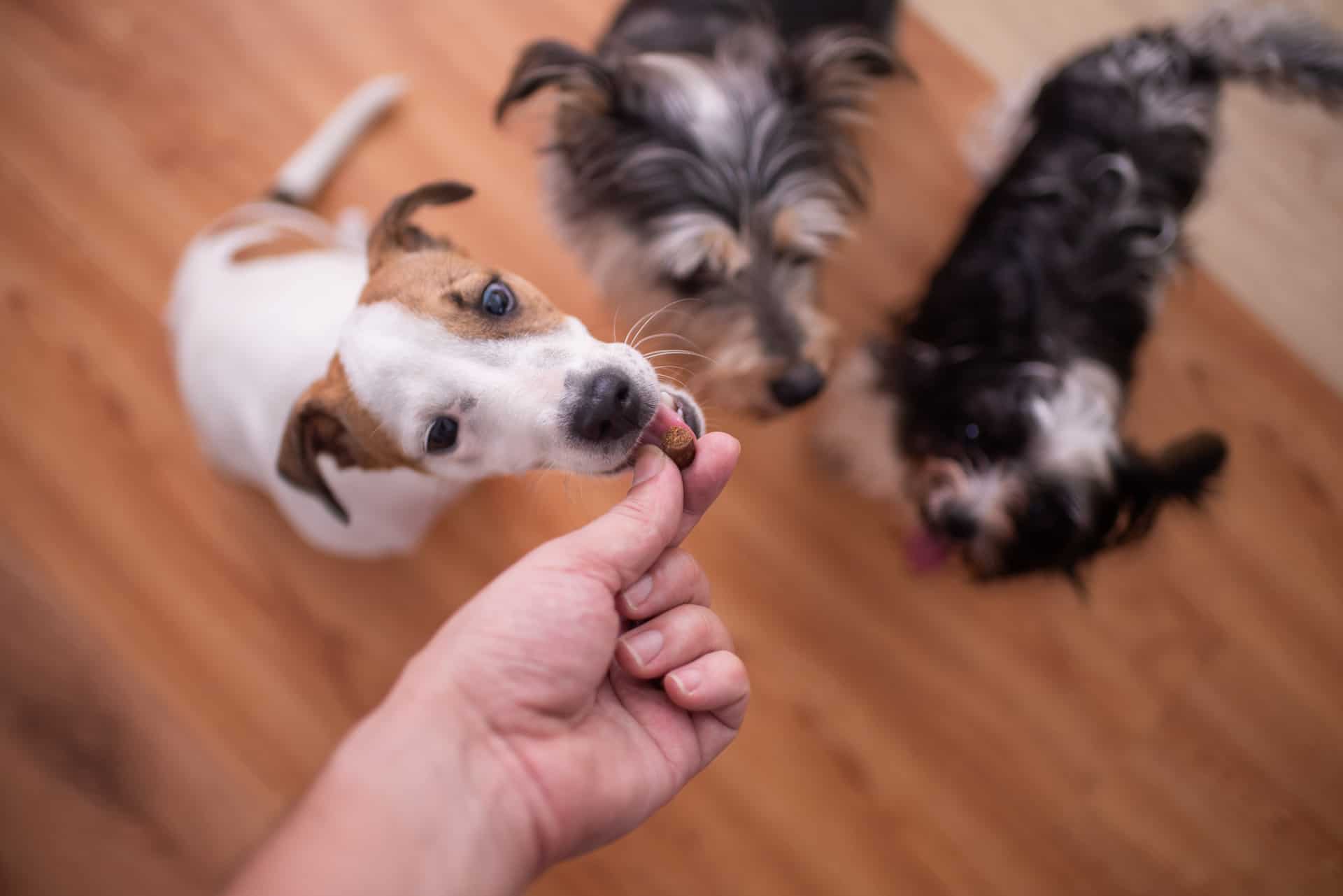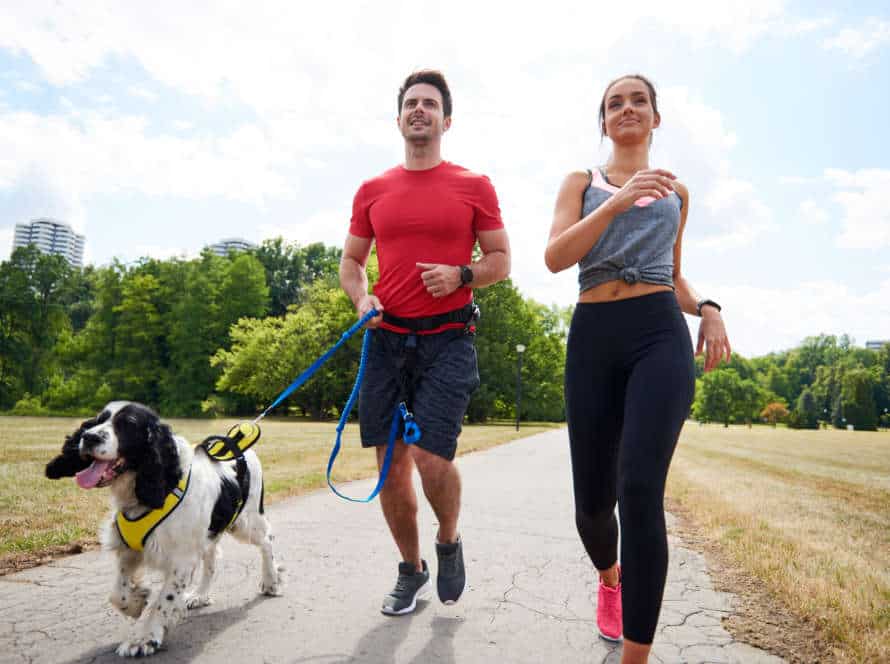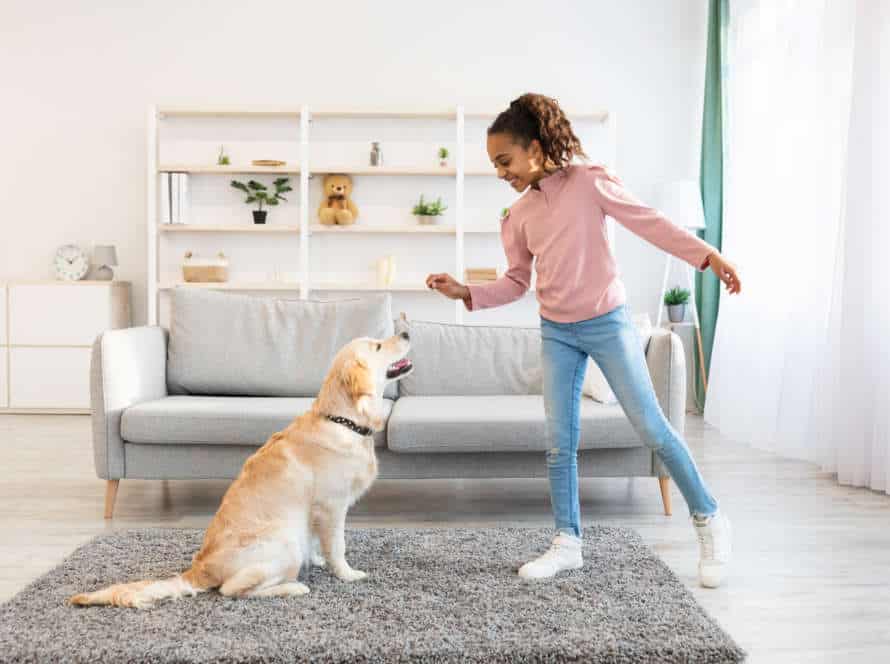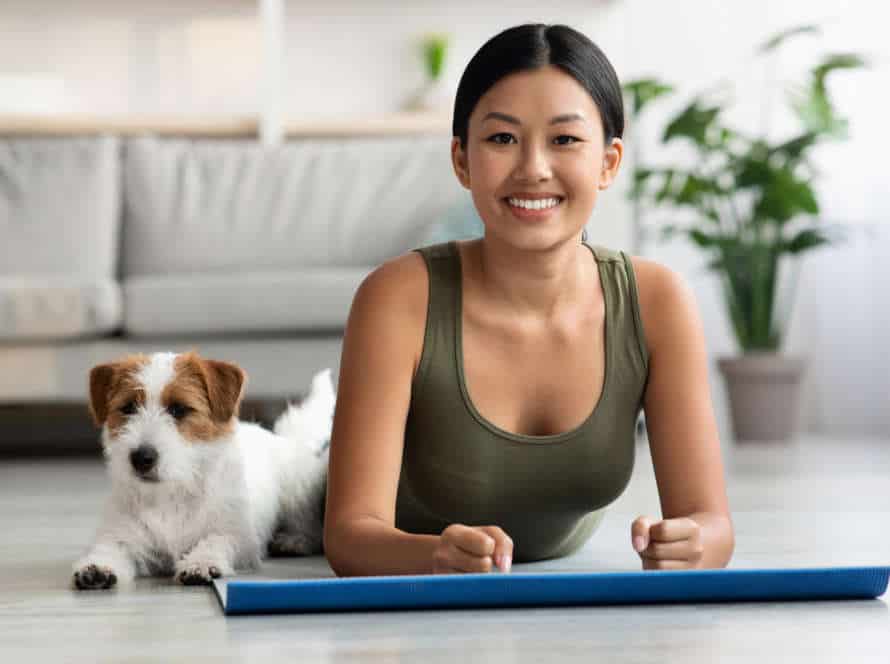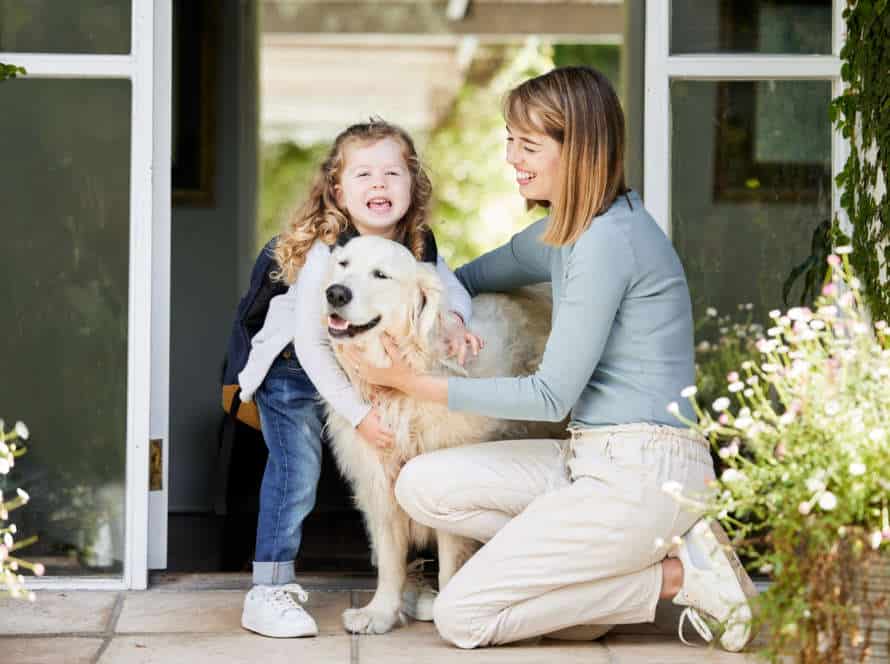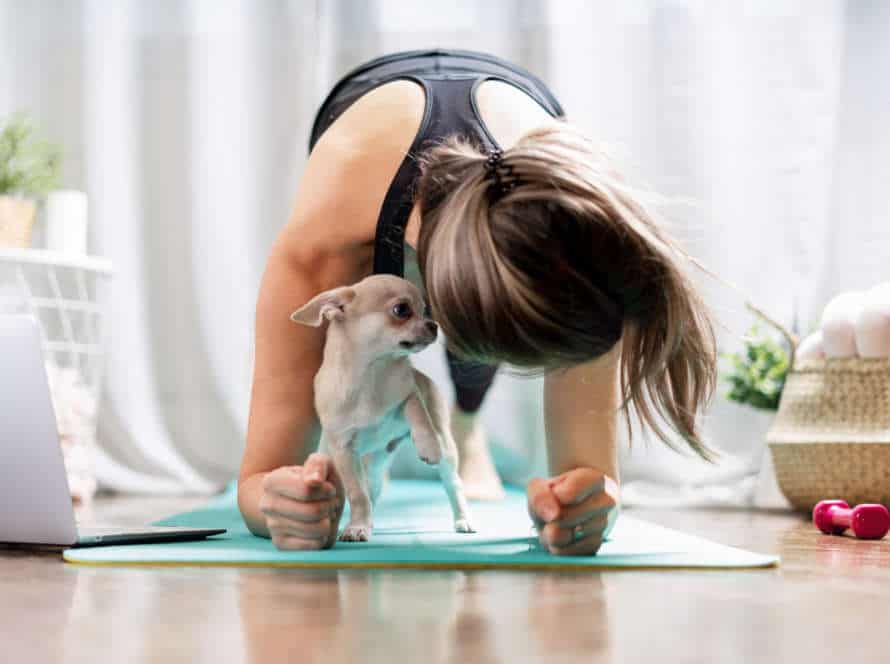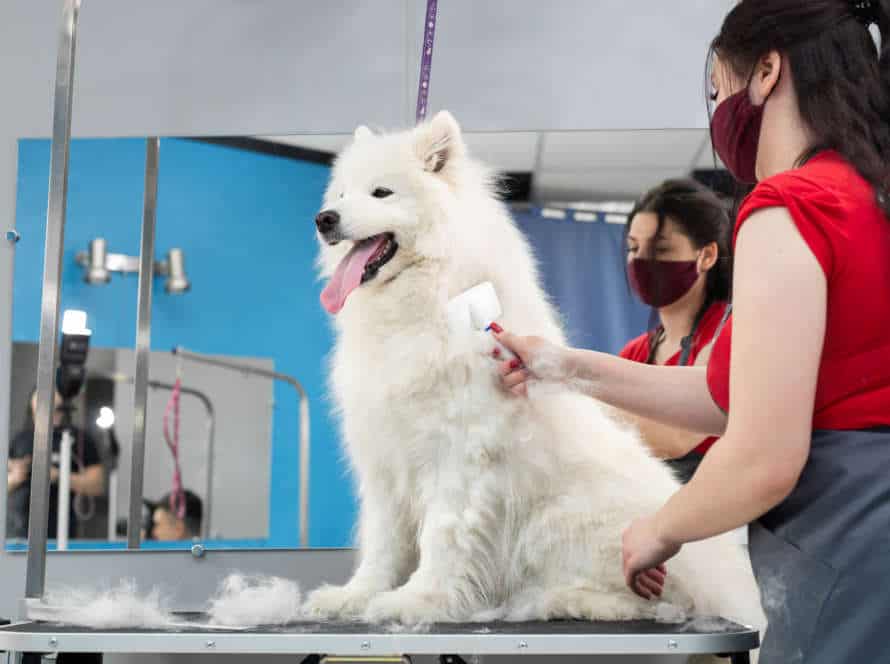Puppy Training 101: Harness the Power of Positive Reinforcement
Positive reinforcement is the most effective and humane way to train your pup. It means giving rewards for good behaviour, rather than punishing bad behaviour. Here are some ideas to help you use positive reinforcement when training your pup:
- Use treats: Give yummy treats to your pup when they do something right. This will help them to learn that good behaviour brings rewards.
- Be consistent: Consistency is key. Make sure you reward good behaviour every time it happens, and don’t reward bad behaviour.
- Use positive language: When giving commands or praising your pup, use kind words and a happy voice. This will make training more enjoyable for both of you.
With patience and consistency, positive reinforcement can help you to train your pup and create a loving bond.
Understanding Puppy Behavior
To train a pup well, it’s key to be aware of their behavior. Like any other pet, puppies give us clues to their requirements through actions like barking, yelping, and yawning. To train them in a positive way, we need to interpret these signs. In this section, we’ll go over common puppy behaviors, the advantages of positive reinforcement, and how to use it when training your pup.
The Socialization Period
The socialization period is key for puppy development. It’s between 3 and 14 weeks of age. This window will shape their behaviour and temperament for life.
For successful puppy training, use positive reinforcement. Introduce your pup to different sights, sounds, smells and textures. Socialize them with other dogs and animals in a controlled environment. Praise and reward them for good behaviour, while discouraging bad behaviour.
By doing this, you’ll help your pup grow into a content, healthy and well-behaved adult.
The Fear-Impact Period
The Fear-Impact Period is a key stage in the growth of puppies. It can shape their long-term behavior and personality. This usually happens when the puppy is between 8 and 14 weeks old. Up to 16 weeks can be included in this period.
The puppy’s brain is receptive to new experiences during this time. They are more likely to develop fears and phobias. As a responsible dog owner, it’s your job to give your puppy positive experiences.
This includes introducing them to different people, animals and environments. Positive reinforcement techniques like treats and praise should be used. Traumatic experiences should be avoided, as they can cause long-term damage.
By creating a loving and supportive atmosphere during this time, you can help your pup grow into a confident and content adult dog.
The Juvenile Period
The juvenile period is a crucial stage in a puppy’s development. It has a big impact on their behavior and future training success. It lasts between 3 and 6 months. This time is marked by rapid physical and mental growth.
Puppies are very impressionable during this period. So, careful attention and positive reinforcement are important to shape their behavior and social skills. Socialization with people, other dogs and different environments is key to avoid fear and anxiety issues later in life.
Rewards such as treats, toys and praise can be used to shape desired behaviors. This will help build a strong bond between the puppy and their owner. Patience and consistency in training is essential to set the foundation for a well-behaved and happy adult dog.
Pro tip: Enrolling your puppy in puppy classes or seeking professional training can be helpful in providing proper socialization and training techniques during this important phase.
Building the Right Foundation
Puppy training? The secret’s out – positive reinforcement! Build trust and communication with your pup by rewarding them for good behaviour. This article will discuss how to use positive reinforcement to make your pup a star student. Let’s get started!
Establishing a Daily Routine
Creating a daily plan is vital for educating your pup. With the correct starting point from positive reinforcement methods, you can set up a routine that’s best for your pup’s growth.
Here are some tips to assist you in creating an efficient daily routine for puppy training:
- Have a fixed wake-up time and meal schedule.
- Include regular exercise and outdoor playtime in your day.
- Incorporate quick, focused training periods into your day, with positive reinforcement techniques and treats.
- Set up a regular bedtime routine for consistency and good sleep.
By having a daily plan that meets your pup’s needs, you can make your bond stronger, help them develop and make training more effective and enjoyable.
Crate Training
Crate training is essential for puppies. It can help with good behavior and positive reinforcement. Here are tips to use this reinforcement:
- Choose the right type of crate. It should be safe, comfortable and fit your puppy’s age and breed.
- Introduce your puppy to the crate gradually. Use treats, toys and positive reinforcement.
- Train for short periods. Increase the duration of the crate time over time.
- Never use the crate as punishment. Make it a safe and positive place for your puppy.
- With consistent positive reinforcement, your puppy will learn to love the crate.
Pro tip: Don’t force your puppy into their crate. Guide them in with treats or toys.
House Training
House training is important for puppies. Positive reinforcement is the best way to do it.
Here’s how:
- Create a routine: Set up a regular feeding schedule and potty breaks.
- Pick a spot: Each time, direct your pup to the same spot.
- Be mindful: Keep an eye on your puppy, and take him to the potty spot when needed.
- Encourage good behavior: Give treats or praise when your pup uses the spot or shows good house manners.
- Remember: Be patient and consistent with the training. Positive reinforcement works better than punishment.
Basic Training Commands
Training your Puppy is super essential! Teach them ‘sit‘, ‘stay‘, ‘come‘, and ‘off‘. Positive reinforcement is key – offer praise and treats. This helps your pup learn commands quickly and effectively. Let’s look at the basics of command training!
Sit
‘Sit’ is a key command for puppy training. Positive reinforcement can help you teach your pup this command, ensuring obedience. Follow these steps:
- Hold a treat by your pup’s nose.
- Move your hand up over their head.
- This will cause the pup to track the treat and sit.
- Say “sit” as they do.
- Reward them with the treat and praise.
- Practice regularly.
- Reduce treats and increase their sit time.
By following these steps and with rewards, you can train your pup to sit on command. This creates a base for further training.
Stay
Positive reinforcement is the best way to train your pup. Here are some commands:
- “Sit”: Hold a treat above their head, then move it back. They’ll lower down and you say “sit”. Give a treat.
- “Stay”: Have them sit, hold your palm out, and say “stay”. Reward after a time. Increase time gradually.
- “Come”: Call their name and say “come”. Give reward or praise when they come. Increase distance between you.
For success: Be consistent and patient. Short, positive sessions help. Rewards for good behaviour too!
Come
“Come” is an essential command for puppies. Positive reinforcement can help teach them to come when called. Here are some tips:
- Use yummy treats and praise to reward your pup for coming.
- Choose a consistent phrase like “come” or “here.”
- Train indoors first, away from distractions.
- Do short sessions; 5-10 minutes max.
- No punishment for not coming. Use positive reinforcement only.
With patience, your pup will learn to come. Then outdoor adventures will be more fun for you both!
Positive Reinforcement Techniques
Positive reinforcement is a great way to train pups! It works by rewarding the behaviours that you want your pup to do. This encourages them to repeat these behaviours. Rewards should be given straight away, so pups understand what’s expected. Let’s take a look at how to use positive reinforcement in puppy training.
Using Treats as a Reward
Doling out treats as rewards is an incredibly effective and positive way to boost your pup’s training. Here’s the drill: Pick small, bite-sized treats your pup loves. As soon as they display the desired behaviour, give them a treat and say nice things or pet their head. Keep reinforcing positive behaviour and ignore the negative. As your pup gets better at showing the right behaviour, gradually reduce the treats.
Talk to them in a positive and encouraging way, never punish or yell. Not only will they learn what you want, but you’ll also build trust. Pro tip: Make training sessions short and frequent, so your pup won’t get bored.
Clicker Training
Clicker training is a popular way of reinforcing good behavior in puppies and dogs. It works like this:
- Link the clicker to rewards, like treats or praise.
- Pick a behavior you want your pup to master, e.g. sitting or coming when called.
- When your pup does the desired action, click the clicker and give them a reward.
- Keep repeating with more challenging tasks.
This method reinforces positive behavior, and builds trust between the puppy and owner. It creates a happy, cooperative pet.
Verbal Praise and Affection
Positive reinforcement techniques for puppy training? Verbal praise and affection are the key. Here’s how to use them:
Verbal Praise: Use your voice to let your pup know when they’re doing something right. Say things like “good job!” or “yes!” in a happy, high-pitched tone. Be consistent with your praise and use it right after the desired behavior.
Affection: Show your pup love as their reward. Pet them, give them belly rubs, or play with them. Timing is important here: give your pup affection right after the good behavior to reinforce it.
Remember: positive reinforcement involves rewarding good behavior and avoiding punishment for bad behavior. Use verbal praise and affection to create a strong bond with your pup as you train them.
Addressing Behavioral Issues
Positive reinforcement works wonders for pups’ behavior. Reward responded behaviors and you’ll see desirable trends emerge. To succeed, consistency and patience are key. Together with positive reinforcement, owners can strengthen their relationship with pup. Socialization and obedience get improved too!
Chewing and Digging
Puppy owners often struggle to address chewing and digging. But, positive reinforcement can help correct these behaviors.
Chewing:
- Redirect your pup’s chewing.
- Give them toys specifically to chew.
- Praise them when they use the toys instead of other items.
- Spray bitter deterrent on things they shouldn’t chew.
Digging:
- Make a safe spot in the yard or sandbox where they can dig.
- When they dig in the wrong spot, direct them to their area.
- Reward them with praise and treats if they dig where they’re supposed to.
Pro tip: Exercise and mental stimulation can reduce the urge to chew and dig.
Biting and Nipping
Pups often bite or nip during teething. To stop it, you need patience, consistency, and positive reinforcement. Here are some helpful tips:
- Give them chew toys – Encourage your pup to use a toy instead of biting or nipping people.
- Reward good behavior – Praise, treats, or affection when they stop biting or nipping.
- Redirect their attention – Offer them a chew toy or treat when they start biting or nipping.
Be aware of your body language and tone. Don’t punish or yell at them. The key to successful training is positivity and consistency.
Excessive Barking
Excessive barking is common in dogs. But, it can be managed with positive reinforcement training. Here are tips:
- Give a treat to your puppy when it stops barking after the “quiet” command.
- Never punish or scold the pup for barking – it reinforces negative behavior.
- Clicker training or treats can be used to reward good behavior, such as sitting quietly.
- Provide enough exercise and mental stimulation to reduce barking.
Be consistent and patient when training your pup. With positive reinforcement and addressing the root cause of excessive barking, you will have a better relationship with your furry friend.
Advanced Training
Your pup has already learnt basic commands like ‘come’, ‘sit’, ‘down’, ‘stay’, and ‘leave it’? Fantastic! It’s time to up their game. Advanced puppy training involves commands like ‘wait at the door’, ‘fetch’, ‘target’ and ‘loose-leash walking’. Plus, you can teach manners and socialization skills. Let’s take your pup’s training to the next level!
Teaching Tricks
Train your pup tricks with positive reinforcement – it’s a great way to deepen your bond and give them mental and physical stimulation. Here’s how to get started:
- Start simple – like ‘sit’ and ‘stay’ – before progressing to more complex tricks.
- Use yummy treats like chicken or cheese to motivate ’em.
- Repeat commands in a happy tone and use positive cues – like ‘good pup’ and ‘well done’.
- Break down complex tricks into smaller parts, teaching each step separately and then putting them together.
- Keep training sessions short and frequent – just 5-10 mins daily – to keep their focus and avoid boredom.
Remember, positive reinforcement is about rewarding good behaviour – so celebrate your pup’s successes with lots of verbal praise, pats and treats!
Agility Training
Agility training is a more advanced kind of puppy training. It helps to sharpen their physical and mental abilities. Positive reinforcement can be used to teach your pup agility. Here are some tips to make the most of it:
- Give treats and praise when they respond to commands.
- Keep the training sessions short and entertaining.
- Make use of different obstacles to keep them engaged.
- Introduce new commands slowly, and praise good behavior.
- Be patient and consistent. Don’t punish them for mistakes.
- Always finish with something positive, and show your appreciation of their effort.
Advanced Obedience Commands
Take your pup’s training up a notch with advanced obedience commands! Positive reinforcement is key. Here are some examples you can teach:
- Heel – have them walk beside you without pulling or lagging, and stay focused on you.
- Stay – train them to stay in a sit or down position without moving.
- Come – important for quickly getting them back to safety.
- Leave It – teach them to ignore things that could tempt them.
Pro Tip: Use rewards and treats when they do something good. Consistency, patience and repetition are the keys to success.
Frequently Asked Questions
1. What is positive reinforcement in puppy training?
Positive reinforcement is a training technique that involves rewarding your puppy for good behavior, rather than punishing them for bad behavior. This can include treats, praise, and other forms of positive feedback.
2. What are some effective positive reinforcement techniques?
Effective positive reinforcement techniques include using treats as rewards, giving praise and affection, and using clicker training. It’s important to find what works best for your puppy and to be consistent with your training.
3. How long does it take to train a puppy?
The time it takes to train a puppy depends on the individual dog and their temperament, as well as the consistency and dedication of their owner. Generally, it can take several months to fully train a puppy.
4. How often should I train my puppy?
You should aim to train your puppy for short periods of time (around 10-15 minutes) several times per day. This will help them stay focused and retain what they’ve learned.
5. Can older dogs learn new tricks?
Yes, older dogs can definitely learn new tricks! However, it may take them a bit longer to pick up new skills than it would for a younger puppy.
6. What should I do if my puppy doesn’t seem to respond to positive reinforcement?
If your puppy isn’t responding to positive reinforcement, it’s important to reassess your training techniques and make sure you’re being consistent and patient. You may also want to consider consulting a professional dog trainer for additional guidance.

